In the April 1999 issue of American Artist magazine the contemporary realist painter Jack Beal is quoted as saying about his commissioned portraits, “I tell my clients that when my portrait of them is finished, they will hate it—and their spouse will hate it even more. I capture more truth in a painting than anyone wants me to reveal, and that’s not necessarily flattering.” He also implies that his portraits’ power to disturb his clients qualifies them as museum-worthy, saying, “I warn my clients they will likely put the finished painting out of view for a while and eventually give it to a museum.”
Walt Whitman made a comparable statement about the nineteenth century artist Thomas Eakins when he said, “I never knew but one artist, and that’s Tom Eakins, who could resist the temptation to see what they thought ought to [be] rather than what is.” Eakins was like Beal in that he insisted on faithfulness to the truths before him, but beyond that the two artists are very different.
Although Eakins was ambitious to immortalize himself through his work, and was probably more concerned about his personal aesthetics than he was about people, his portraits never put his subjects beneath him. In fact his paintings often mirror and sometimes parallel the qualities of the people he painted. His portrait of the famous pioneering surgeon Dr. Samuel Gross is a remarkable example of that because it is an obvious, and I think successful, effort to put himself on equal footing with Gross—without diminishing Gross’s stature in any way.
Good composition in a portrait generally indicates an artist’s respect for his subject, or at least of what that person represents, because the solidity and grace it imparts suggests that comparable traits exist within the subject’s character. In light of that fact, the contrast between these two artists becomes even more apparent.
In the article mentioned above, “Jack Beal’s Portraits of Life,” the author Stephen Doherty emphasizes Beal’s interest in composition: “Beal frequently lectures and writes about composition, constantly urging artists to create the illusion of greater and livelier space within their pictures.” Beal’s early paintings sometimes had a rhythmic flow within the figures themselves but his later commissioned works, even within the figures, have none of that movement. Rather than creating the “lively space” he describes in his lectures, his pictures are often static, the shapes are sometimes repetitive and the compositions in general lack a prioritizing of the order in which the viewer’s attention is held. That is tantamount to not composing at all. Compare his composition in the portrait of President Olin C. Robison that hangs in the Middlebury College in Vermont with Eakins’s painting of Dr. Samuel D. Gross, painted for the Gross Clinic and now hanging in the Philadelphia Museum of Art.
[NOTE: To see Beal’s portrait, go to www.jackbeal.net/89_robison.html ; copyright prohibits us from making the image available here]
Eakins’s painting of Dr. Gross is built like a grand temple, a tribute to science and to the virtues of thought and accomplishment. It is architecturally solid and within that structure is a carefully choreographed scene. The combination of shapes and the lighting and shadows provide the same order of succession that dialogue and movement create in a masterful stage production. Eakins does not restrict our movements. Instead he gives us logical and inviting options. He allows us to travel throughout his illusionary space along any of many pathways, each one prescribed to give us the fullness of his experience of the scene. He imagines that each of us would enter the pictorial space from a different place with different initial interests and gives us the added option of changing course as our pathway crosses others, but he brings us all to the same ultimate conclusion or completion once we have absorbed the entire picture. None of the routes we might choose are boring. There is no redundancy in shapes or in emotional content. Each figure, including the patient and the students in the gallery, is playing a unique role with a different, very expressive gesture that is an integral part of the whole.
The scene Eakins created, and still creates, has stillness yet moves and has power. We feel a momentary hesitation between events, as if Dr. Gross has deliberately paused in his address to punctuate his last statement or to gain the audience’s full attention before his next point. Even the mood is a careful balance of various elements in the room.
Every small section in this pictorial space is accounted for. There is nothing extraneous. Nothing is overstated or understated. Eakins’s creation is a compositional masterpiece. It is an ideal that even he could not always live up to but which points the way for any person who aspires to create works that have lasting quality. It also should be instructive to those who, like Beal, have elitist notions about their compositional acumen when, in fact, they have taken a rather lackluster approach from start to finish.
By comparison with Eakins portrait of Dr. Gross, the realism that Beal proudly extols holds little interest for most of us, and his unwillingness to go beyond that, to add to that reality in any enriching way, makes his efforts seem empty, banal and pointless.

